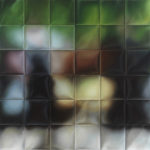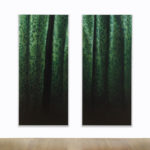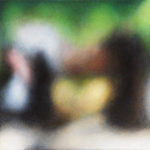Steven Carrelli
I employ a variety of strategies to examine the uncertain nature of perception and to explore representation as a means of interpreting our relationships to place, time, labor, and history. I work primarily in painting and drawing, and I often combine direct perceptual experience and art historical imagery. Many of my works simultaneously use and subvert the practices of trompe-l’oeil by suggesting the illusion of space and then thwarting that illusion within the same composition.
Profane Mimesis is a series of paintings that take Hans Holbein the Younger’s 1533 painting The Ambassadors as a model through which to examine the formal and expressive possibilities of representation. Holbein’s painting is a tour de force of sixteenth century Northern European realistic representation that expresses an extraordinary attention to observable details while also including a prominent and spatially ambiguous anamorphic image that complicates both the painting’s visual illusion and its content. In the Profane Mimesis series, I use a combination of selective imitation and alteration of the details of Holbein’s painting to explore the complex relationships between observation, representation, memory, and cultural value.
The title Profane Mimesis is derived from Pier Paolo Pasolini’s fragmentary prose-poetic work La Divina Mimesis. Based on the first seven cantos of Dante’s Inferno from the Divine Comedy, Pasolini’s La Divina Mimesis combines social critique with aesthetic and linguistic analysis. By echoing the form and content of Dante’s poem, he probes the relationship between language, aesthetic form and the cultural construction of meaning. Similarly, the paintings that constitute Profane Mimesis are defined by a form of visual poetry that takes the practice and syntax of pictorial representation as both its subject and means.
These paintings were created with the assistance of two grants from the City of Chicago Department of Cultural Affairs and Special Events (DCASE).







